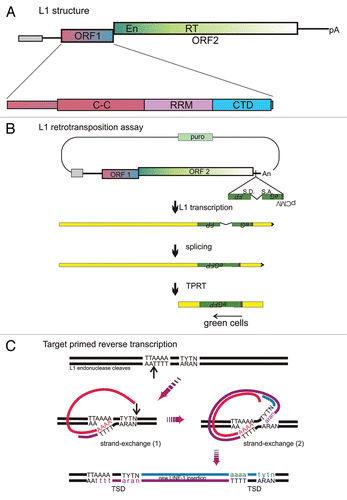Figures & data
Figure 1 LINE-1 structure and life-cycle. (A) Schematic of L1, depicting from 5′ to 3′: internal promoter (gray box), 5′ untranslated region (UTR, line), ORF1 and ORF2 with endonuclease (En) and reverse transcriptase (RT) domains, 3′UTR (line), polyA (pA) signal which is followed by an A-rich tail. This entire element is typically embedded in a recognizable target site duplication in genomic DNA. The enlargement of ORF1 depicts its three domains: C-C, coiled-coil; RR M, RNA recognition motif; and CTD, C-terminal domain. (B) Assay for retrotransposition of L1. The transfected plasmid contains a selectable gene (puro), origin of replication (not shown) and an intact L1 with an anti-sense intron marked reporter gene embedded in the 3′UTR, in this case eGFP (S.D. and S.A. indicate the splice donor and acceptor sites, respectively). After insertion of the spliced cDNA product of retrotransposition, cells can express eGFP, but not before. The two L1-proteins are required in cis, thus associate with the L1 RNA that encoded them, converting it into the L1RNP that interacts with genomic DNA to insert a new copy of L1 by TPRT. ORF1p is likely present in the RNP at much higher stoichiometry than ORF2p, based upon efforts to detect both proteins in cells.Citation28,Citation58,Citation62 If ORF1p coats the RNA as a trimer binding 50 nt, 140 trimers would be needed for the 7 kb RNA whereas likely just one dimer of ORF2 is needed, predicting a 200-fold excess of ORF1p compared to ORF2p.Citation30 (C) Details of L1 reverse transcription with insertion at the target site by TPRT. The depicted reaction is a sequential TPRT, initially using L1 RNA as the template, followed by L1 first-strand cDNA; but both reactions are primed by the L1 endonuclease and extended by L1 RT. ORF1p may help with the strand transfer required to anneal the genomic primer to the L1 RNA (1) or cDNA (2) templates or facilitate primer extension during reverse transcription or both.Citation20 TSD, target-site duplication.
